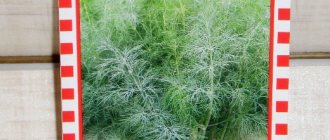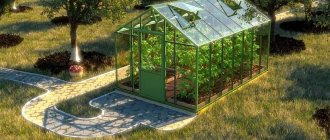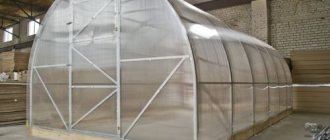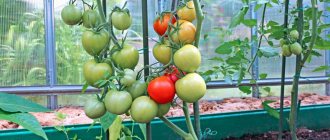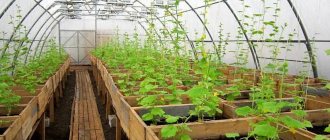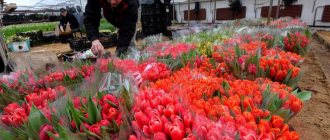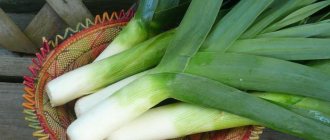The share of roses is almost two-thirds of the total number of flowers sold through shops and pavilions. Standing in an endless line for a bouquet for the next holiday, more than one aspiring entrepreneur thinks about how profitable it is to produce such a product all year round. Of course, to a person far from floriculture, such a business seems quite complicated and risky. Meanwhile, the technology of growing roses in a greenhouse for sale has long been known to gardeners, so mastering it for a beginner is only a matter of time and desire.
What varieties of roses are suitable for growing?
Obviously, the goal of growing roses in a greenhouse as a business is primarily to obtain the maximum number of quality buds. Therefore, the farmer needs to study the characteristics of various crop varieties in order to choose among them the most suitable for indoor soil. All of them are divided into several varieties:
- Polyanthaceae. They form massive clusters of dozens of small flowers in white, yellow, red or pink. The bushes grow up to 60 cm in height, but the stems themselves are short, so it is difficult to sell roses individually;
- Miniature. They are distinguished by bushes up to 40 cm high and small inflorescences that densely cover the plants. Suitable for growing as ornamental plants - for example, in pots on balconies or along paths in the garden;
- Hybrid tea. Plants familiar to everyone with long stems and dense inflorescences, presented in all flower stalls. They cannot be considered unpretentious, but these varieties are of great commercial importance;
- Teahouses. They have dense single inflorescences on short stems. The common range is standard and combined colors. They have a rich aroma and are usually sold in large bouquets;
- Peony-shaped. They have dense bell-shaped inflorescences with dozens of petals. Each shoot usually opens several buds, which is why peony roses are used for lush wedding bouquets;
- Floribunda. They are distinguished by lush and large multi-petal inflorescences of various shades. The bushes grow up to 1–1.2 m in height. They occupy an intermediate place between polyanthas and hybrid teas, and are often odorless;
- Grandiflora. The result of crossing floribunda with hybrid tea roses, bred no more than forty years ago. They have shoots up to 2 m high and huge lush inflorescences of white, yellow, red or pink shades.
To grow roses in a greenhouse all year round, breeders have created dozens of different varieties of almost all varieties. Here are the most interesting of them:
- Abracadabra. Hybrid tea rose 60 cm high with variegated striped or spotted burgundy-yellow flowers;
- Black Baccara. Hybrid tea rose up to 80 cm high with huge velvety dark cherry, almost black flowers. Has few thorns;
- Carina. Hybrid tea rose up to 110 cm high with delicate creamy pink flowers. It has a strong aroma and dark leaves;
- Casanova. Hybrid tea rose up to 90 cm high with large golden or pink-golden flowers;
- Lolita. Hybrid tea rose up to 100 cm high. It has cream-colored petals with a red or pink base and edges. Has a strong odor;
- Memoire. Snow-white hybrid tea rose with flowers 10–12 cm in size. In hot weather it turns pinkish. Plant height - up to 120 cm;
- Rose Gaujard. Hybrid tea rose 100 cm high. Distinguished by white petals with a pink or cherry base and edges;
- Pat Austin. A peony rose of copper-orange color, up to 105 cm high. The inflorescences are large, cup-shaped, up to 12 cm in diameter. The smell is similar to rose oil;
- Carte Blanche. Floribunda rose with large cream or white flowers. The bush reaches a height of 100–110 cm;
- Niccolo Paganini. Bright red or scarlet floribunda with velvet flowers 8–10 cm in diameter. The plant reaches a height of 110–120 cm;
- Queen Elizabeth. Floribunda is a rich pink color with dark green leaves and shoots up to 100 cm high;
- Scarlet Gem. A miniature rose with a bush up to 40 cm high, densely strewn with bright red flowers with a diameter of 3–5 cm.
Rose - queen of flowers
A beautiful rose, from time immemorial, has been considered the queen of the garden, towering majestically above all flowers, it is considered the best flower for a gift, regardless of the occasion and age of the recipient.
Rose is a flower that is originally classified as a member of the Rosehip genus. The first mentions of these flowers come from Ancient Rome and Greece. Initially, all plants were grown by humans only for medicinal purposes, but they could not help but notice the beautiful flowers. Thus, through crossings, the beautiful rose appeared in Roman gardens.
In Russia, mentions of this flower date back to the sixteenth century, but they began to be grown and distributed only during the reign of Catherine the Second. First in the gardens of palaces, then in the estates of the rich, the rose won love within itself.
Color Differences
Garden roses of various types and varieties delight the eye in almost every yard or garden plot
A large number of species and varieties of this flower do not stop growing to this day. The main groups are considered to be garden flowers (in the form of heat-loving bushes), park flowers (beautiful hybrid and wild-growing) and climbing flowers (which wrap around some support).
Roses are also divided according to the number of petals in a flower:
- Simple - flowers have no more than seven petals.
- Semi-double - flowers can have from eight to twenty petals.
- Terry - having more than twenty petals in a flower.
You can also divide flowers according to their colors, even if they have mixed colors with a transition, the main groups are:
- White mixture – basic white.
- The yellow mixture is the main yellow.
- The orange mixture is the main orange.
- The pink mixture is the main pink.
- The red mixture is the main red.
- The purple mixture is the main purple.
- Brown mixture – basic brown.
- Multi-colored - if there are several unmixed colors.
They can also be divided by the size of the flowers, by the number of flowers on one stem, by the duration of their flowering, by the way they grow, and much more.
Ways to grow roses
Comparing growing roses in open ground with planting them in a greenhouse, it should be noted that under the protection of polycarbonate, the farmer gets more opportunities to control the microclimate, prevent the influence of weather conditions and increase crop yields. You can place bushes in the greenhouse space in different ways:
- On the beds. For planting plants, a nutrient substrate is prepared, which is poured in the form of ridges a meter wide, 70–80 cm high. On each of them, with a row spacing of 25–30 cm, four to five rows of bushes are placed;
- In pots. This technology is suitable for growing roses at home - in a room, on a balcony. Miniature varieties are planted in plastic boxes or containers 30–40 cm high, filled with drainage expanded clay and substrate;
- On hydroponics. Suitable for saving space in large greenhouse complexes. The bushes are germinated in seedling cubes and placed on mats made of coconut fiber or stone wool, inside which a nutrient liquid circulates;
- On the rootstock. This method of growing roses involves grafting onto ordinary rosehip bushes that have a powerful root system and strong stems. First, they are planted in pots and then transferred to closed ground.
Basic rules of cultivation and care
To grow beautiful and vibrant roses, they must be grown correctly and provided with appropriate care. Beginner gardeners need to know the main points:
- Conduct daily drip watering of roses. This will allow water to get not only under the flower bush, but also onto the leaves themselves;
- Feed every month;
- Periodically loosen the soil near the roses for better air circulation;
- Regularly get rid of weeds;
- Monitor the maintenance of the required microclimate. Optimal temperature conditions: soil - +12°C, air - +22°C;
- Monitor the humidity level. Favorable is 70%;
- Provide plants with good 16 hours of light per day. In the autumn-winter period, if there is a lack of sunlight, use additional lighting (phytolamps). In the summer, the greenhouse is covered with roller shutters or thin woven materials, this will avoid burns of the leaves.
It is also necessary to trim the shoots and cut off the buds. This will increase the flowering period and rejuvenate the bush.
Basic rules for these procedures:
- Regardless of the variety, when shortening the shoots must have a minimum length of at least 30 cm and 7-12 buds on each;
- To prevent the bushes from becoming depleted, the lateral flower stalks of roses, which are weaker, are removed. This will allow the bush to concentrate on a small number of buds, and they will be larger and brighter. As soon as they are removed, the roses will begin their next flowering period.
Pre-treat all garden tools with a disinfectant solution. The cutting accessories should be sharpened well; the blades should be free of nicks and irregularities.
At the initial stage of growing roses in greenhouse conditions, you may encounter possible difficulties and costs associated with the construction of a greenhouse and the creation of all the conditions necessary for the growth of roses. But a careful and adequate approach will make cultivation a profitable business.
Rose growing technology:
How to prepare the soil for roses?
One of the main features of growing roses in a greenhouse is the need to use the same soil for several years, which is replaced only when the plantation is completely renovated. It is logical to assume that ordinary land is not suitable for such purposes. Therefore, the farmer needs to take care of saturating the soil with nutrients. How to prepare a place for planting rose bushes:
- The easiest way to purchase soil is ready-made. But if desired, it can be made from a mixture of 50% garden soil, 35% last year’s manure and 15% sand;
- The finished substrate is thoroughly mixed, adding 20 g of potassium nitrate, 30 g of superphosphate and 400 g of wood ash per cubic meter;
- The result should be a mixture with an acidity pH of 5.5–6.5 and a mass density of about 1200–1400 kg/m³;
- After marking the beds in this place, the soil is removed to a depth of 50–60 cm. A drainage layer of crushed stone is installed at the bottom and pipes are laid to drain water;
- Then the pits are filled with substrate so that the beds rise 20 cm above the adjacent paths;
- The soil is thoroughly watered to settle it, after which the missing layer is added. After a week, it is loosened and holes are prepared for bushes.
Conditions
To get a good result you need:
- select certain varieties;
- use high-quality substrate;
- Impeccably maintain the required planting density;
- organize a regulated irrigation system;
- apply fertilizers in a timely manner;
- cut shoots regularly;
- trim bushes correctly.
If all necessary conditions are met, forcing roses in a greenhouse will give excellent results.
Variety selection
Rose variety "Rose Gozhar".
When choosing rose varieties for planting in a flower greenhouse, it is better to choose those that have stable immunity to common diseases, primarily powdery mildew.
The following properties are inherent in the varieties:
- "Rose Gozhar";
- "Queen Elizabeth";
- pink hybrid "Carina";
- orange hybrid "Baccara";
- white rose "Pascali";
- golden rose “Casanova”;
- red and yellow miniature roses “Little Flirt”;
- orange miniature roses “Skarlet Gem”;
- rich red color of the Beauty Secret rose.
The constant work of breeders to develop new varieties makes greenhouse roses less capricious to the required conditions. Thus, varieties have already been bred that do not require constant intense lighting.
Among them are:
- red rose buds of the new variety “Zorina”;
- yellow buds of roses of the “Geheimrat Duisberg” variety;
- rich red buds of roses of the “Better times” variety.
How to choose rose seedlings?
When the greenhouse soil is ready, you need to think about how to obtain planting material. The most suitable option is selected taking into account how much time, effort and money the farmer plans to allocate for these purposes:
- From cuttings. To grow roses from cuttings at home in the summer, cut out an area with one or two buds from a strong shoot. The segment is treated with a stimulant and germinated in a pot, after which it is transplanted into the ground;
- From seeds. To grow roses from seeds at home, the plant is allowed to bloom, after which the seeds are extracted from the fruit. They are soaked and placed in the refrigerator, and as they germinate, they are planted in peat cups;
- From seedlings. This method is recommended for beginners or farmers who want to save time. If you are planning to open a business growing roses, it is better to purchase seedlings not at the market, but at gardening centers or nurseries.
Preference should be given to two-year or three-year-old seedlings: as a rule, they are already quite viable plants. Unfortunately, sellers are usually interested in selling planting material at any cost, so a beginner should figure out how to distinguish a good seedling from a bad one:
- The plant must have at least three strong shoots with smooth elastic bark without wrinkled areas or dark spots;
- To check, the bark at the top of the shoot needs to be scratched a little. A good seedling will have light wood, and the damaged area will be moist with sap;
- The buds should be closed or slightly hatched. If they open and white feeding threads appear on the roots, the plant has already woken up;
- At the site where the varietal rose is grafted onto the rootstock and near the root collar there should be clean bark, without signs of peeling or rotting;
- The strong seedling has a developed root system. If short stumps remain instead, such a plant will not produce a productive bush;
- The roots should have dark brown bark and light wood underneath. When cut, juice should also be released from them;
- For seedlings with a closed root system, the packaging and transport soil should not be too wet or too dry.
Is it possible to graft roses in greenhouse conditions? If yes, then what is the correct procedure?
It is possible, and even necessary, to graft plants. Rosehip is used as a rootstock. A varietal rose grafted onto it will be stronger and more resistant to adverse conditions. The rootstock is chosen that is older than 3 years.
Budding is carried out in the middle years as follows:
- the soil is raked away from the rose hips, exposing the root collar;
- wipe it from dirt with a damp cloth;
- a bud with a piece of bark and cambium is cut from an annual cutting of a varietal rose;
- a T-shaped incision is made on the prepared root collar, the bark is folded back, and a bud is inserted;
- The scion and rootstock are combined and wrapped with film so that the bud remains open;
- The root circle is covered with earth.
The vaccination usually takes root within a month.
How to plant roses?
When picking up seedlings from the store, you should remember that they are in an unfamiliar environment. Therefore, before planting, rose bushes need to be helped to get out of the state of shock by carrying out some preparatory measures:
- Plants with ZKS are removed from the packaging and freed from peat. The roots are straightened, removing dried and damaged shoots;
- The day before planting, the roots are disinfected for 10–15 minutes in a solution of copper sulfate, after which they are soaked for 16–20 hours in water with the addition of a growth stimulator;
- Weakened shoots are cut off, leaving 2–3 stems on the seedling with several buds on each. The sections are disinfected and dried.
The most common way to grow roses in a greenhouse is to plant bushes on ridges. How to perform this operation:
- A week before planting, they begin to warm up the greenhouse so that the soil temperature at a depth of 5–6 cm reaches 11–13°C;
- In meter-wide beds, holes of sufficient size are dug every 30–35 cm with a row spacing of 25 cm. The planting density is 8–12 pcs/m²;
- The seedlings are placed in the holes so that the grafting point is at soil level. The roots are straightened and covered with soil, periodically compacting it;
- Stronger plants are placed in the center, and weaker ones are placed at the edges. The bed is made slightly convex by adding more soil to the middle;
- After the operation is completed, the bush is watered abundantly to ensure that the soil around the roots settles.
Trimming
Pruning roses is necessary for better growth of this crop. Be sure to remove all shoots from the side. Buds should not be left either. You can only leave a shoot with several strong buds, from which new stems will appear in the future. The shoots will be able to bloom a second time soon; it usually takes about 45 days before the pruned bushes are completely formed.
When pruning, do not remove leaves in large quantities. Thanks to their presence, new shoots will develop more intensively. The best time for pruning is morning. During this period, the buds are still closed, and the procedure is easier. You can collect a lot of flowers in a greenhouse, given that one bush produces about 10 flowers on average. But for this you need to take good care of your plants, properly care for them, from the moment of harvesting seedlings to cutting and storage.
How to care for roses?
Growing and caring for roses is a rather complex process. These plants are considered to be quite delicate: if left unattended for several days, you can lose a significant part of the harvest. In a word, the farmer will not be left without work:
1. Plants require temperature regulation depending on the growing season. An entrepreneur must follow this algorithm:
- Immediately after planting, set the temperature to 10°C at night and 12–14°C during the day;
- After the buds open, the air is heated to 15°C;
- When leaves appear, the temperature is increased to 18°C;
- At the stage of bush formation, maintain 22°C;
- After the buds appear, the air is cooled to 18°C during the day and 16°C at night;
- After cutting, shoot growth is stimulated by increasing to 22°C;
- In summer, do not allow the greenhouse to warm up above 25–30°C.
2. Humidity in the greenhouse is maintained at 65–75%. It is regulated by ventilation or spraying water mist using fans;
3. Although photosynthesis begins at 2000 lux, in winter the beds are illuminated with an intensity of 6000–8000 lux for 18 hours a day;
4. On hot summer days, to reduce the temperature and protect plants from sunlight, the greenhouse is curtained with a special translucent material;
5. To moisten the soil to a depth of 50–60 cm, intensive watering is carried out. In this case, they adhere to a certain schedule:
- From November to March - every 10 days;
- From March to May and from September to November - every 7 days;
- From May to September - every 4 days.
6. A day after each watering, the soil in the beds is loosened to break the crust and facilitate the penetration of air to the roots;
7. The greenhouse is regularly ventilated. In summer, the windows are simply opened, and in winter, air is pumped through fans with preheating on heat exchangers;
8. To prevent the evaporation of moisture from the soil surface, the area around the plants is mulched with peat, straw or sawdust;
9. Bushes are fed monthly. The technology for growing roses in a greenhouse includes the addition of 40 g/m² superphosphate, 15 g/m² nitrate and 15 g/m² potassium;
10. After collecting the flowers, the plants are pruned, leaving 3-4 strong shoots on the bush. Each second-order sprout is also shortened so that 2–3 buds remain on them;
11. In December and January, roses have a rest. The bushes are pruned, watering is stopped, and the temperature in the greenhouse is reduced to 2–3°C.
Greenhouses on a personal plot
The types of greenhouses you will use to grow roses directly depend on the start-up capital you have and, accordingly, the scale of your flower business. If you plan to organize such a business with minimal investment, then you can get by with ordinary greenhouses on your own plot of land.
First of all, before building greenhouse structures, you will need to obtain a document confirming the fact that you are the owner of a personal household plot (LPH). This document is issued by local government bodies, which include, for example, the administration of a rural settlement or a gardening partnership (depending on where the plot you own or rent is located). Unlike a peasant farm or individual entrepreneur, private subsidiary plots do not have legal status.
However, this form has a number of undoubted advantages, which include the absence of the need to pay taxes and the absence of reporting. Disadvantages include limited options for selling finished products. So, for example, you will not be able to sell your flowers through wholesale companies, markets, flower shops, etc. The only option is to sell roses to resellers who do not pay very much. On the other hand, when the business takes off, you will be able to register as an individual entrepreneur and sell your products at your own outlet.
Today there are a large number of different options for greenhouse structures for growing flowers. Each of them has its pros and cons. In this article, we will look at the most popular greenhouses made of polycarbonate among gardeners. Wood is being used less and less as a material for frames due to its high cost, heavy weight and fragility, and increasingly experts are giving preference to frames made of steel profiles coated with zinc, which is resistant to corrosion.
Cellular polycarbonate is a modern material that is quite durable (compared, for example, to glass or, especially, film), fire- and wear-resistant, and almost transparent. In addition, this material has good thermal insulation, excellent light transmittance and dispersion, protects plants from sunburn, and is easy to drill and cut.
The maximum width of such a greenhouse is 5 meters. The length can be any, but sizes within 15-20 meters are more common. Although polycarbonate can be used to create almost any type of structure, including dome-shaped ones, however, it is still recommended to make the roof of such a greenhouse pitched with a height of the southern wall 0.5-0.7 meters lower than the northern one. This design ensures uniform illumination of the greenhouse: the sun's rays will pass through the pitched roof under a more direct beam, warming up the entire space inside the greenhouse. The greenhouse is installed from west to east, and the wall that faces north is made opaque (for example, from a cinder block or a wooden beam).
Greenhouses of this size are rarely made independently, because to do this you need to have not only knowledge, but also special equipment. Some models of polycarbonate greenhouses that are on sale are often already equipped with an economical drip irrigation and ventilation system.
The equipment set may also include a fog-forming unit for cooling the greenhouse, a curtain system for darkening, or, conversely, additional lighting. Very popular is automatic equipment for preparing and supplying solutions for feeding flowers, as well as for maintaining a given temperature and humidity in a greenhouse. Of course, you will have to pay for all these bonuses.
The cost of the simplest polycarbonate flower greenhouse starts from 100 thousand rubles. The structure described above with an area of 100 square meters. meters will cost several times more - in the amount of 500 thousand rubles.
Diseases and pests of roses
Unfortunately, when breeding many spectacular varieties, breeders had to sacrifice the unpretentiousness of plants for the sake of beauty. Therefore, roses often suffer from fungal and viral diseases, which are well known to farmers in businesses such as raspberry growing. You can fight them by spraying plants with systemic fungicides, sulfur preparations and Bordeaux mixture:
- Powdery mildew. Covers leaves, young shoots and buds with a white coating, which causes their gradual death;
- Rust. Appears on the stems as an orange dusty mass. The growth of the bushes stops, the leaves and stems dry out;
- Tracheomycosis. It affects roots, growing in their vascular system. The shoots become brown and brittle and begin to rot;
- Root cancer. It looks like ugly bumpy growths of different sizes. Infected plants stop growing and die;
- Stems cancer. Covers the bark of the shoots with depressed brown spots, in place of which deep ulcers subsequently form;
- Downy mildew. Appears on the leaves in the form of yellow dry spots. Fluffy mycelium is visible on the underside of the plate. Leaves curl and fall off;
- Septoria. Covers the leaves with small cream spots with a brown border. As the disease progresses, the leaf blades die;
- Phyllosticosis. On roses it appears as dark brown or red spots that cover the leaves. The affected parts of the bush dry out;
- Cercospora blight. It appears on the leaves as small gray spots with a wide brown border. Then they cover the entire surface of the leaf blade and cause its death.
There is a widespread belief that in greenhouses there is no need to fear the invasion of insects that damage plants during the process of growing roses in the open ground and caring for them. But experience shows that various pests often appear in closed ground, which should be destroyed with insecticides and acaricides:
- Slobbery pennies. Coleoptera fly 5–12 mm long. Has green wings with a black stripe. Adults and larvae feed on leaf sap;
- Rose aphid. Scarlet insect 1–2 mm long. Forms colonies on leaves and buds, as a result of which they dry out and fall off;
- Spider mite. An insect 0.5 mm long with a red or green body. It feeds on the juice of leaves and young shoots;
- Rose leafhopper. Light green coleopterous fly 3–4 mm long. The larvae eat rose leaves, leaving light marks in the form of stripes and dots;
- Rose sawfly. A family of eight different insects with a brown body 8–10 mm long. The larvae gnaw holes in the shoots and develop there;
- Roseate borer. Bronze-green beetle 6–8 mm long. Its larvae feed on leaves and stems, leaving behind thickenings - galls;
- Gall midge. A mosquito-like fly 2–3 mm long with a brown body. Penetrates shoots and feeds on sap. In these places, spherical growths form;
- Leaf roller. A family of three butterfly species with brown spotted wings. Caterpillars eat young leaves and shoots.
GUIDE. A unique rose garden operates in Vladikavkaz
Reviews:
Bers Barakhoev
writes: at what address can I find you?
Alex and German
writes: why so small?
ian popovici
writes: what do your roses grow from, from seeds.
Bers Barakhoev
writes: at what address can I find you?
Growing plants in December-January is not so profitable. Moreover, the flower is considered a summer flower and therefore needs more light. The introduction of artificial lighting has a bad effect on the gardener’s budget. The most profitable time is spring, just before March 8th. Buyers are in great demand for fragrant flowers that do not contain harmful substances.
How to cut and store roses?
When organizing business processes, an entrepreneur must know how long a rose grows in a greenhouse. The first full-fledged buds will appear within a month and a half after planting, and in the future the bush will produce new flowers every 5–7 weeks. During the harvesting process, you need to follow some rules:
- Roses are cut until they fully bloom and the buds remain dense. In order not to deprive the plant of leaves, no more than 30% of the flowers are collected at a time;
- The operation is carried out in the early morning or evening, when the concentration of water and sugar in the shoots reaches its maximum. This way roses last longer;
- For cutting, use a sharp knife or pruning shears, treated with a disinfectant solution to prevent infection;
- The collected roses are placed in the refrigerator and cooled to 6–8°C so that they can withstand long-term transportation.
When growing roses for sale, you will have to take care of preserving the flowers until they are shipped to customers. The fact is that the metabolism in cut buds does not stop, and it can only be slowed down by cooling. In practice, dry and wet cold storage are used. For dry storage:
- Barely colored buds are placed in sealed bags to isolate them from the external environment and placed in a refrigerator with a temperature of 0–1°C;
- Slightly blossomed flowers are wrapped in packaging with holes for gas exchange and kept at a temperature of 3–8°C;
- Roses are stored horizontally or hung vertically on special lattice shelves for 10–15 days.
The wet method allows you to slightly extend the life of flowers by feeding the buds with useful substances from the solution:
- To store flowers, prepare an aqueous solution from sugar and special preparations such as Vitant, Nora, Bud;
- One-third of the plants are placed in vessels with bars and placed in refrigeration chambers at a temperature of 1–2°C;
- With constant control of temperature and humidity, plants are stored in a wet way for at least 15–20 days.
Cutting off the buds
Beautiful roses, of various shapes and colors, will decorate any home, bringing a good mood with their unsurpassed appearance and sweet smell.
If you want to get strong, stable shoots with large, bright buds, it is necessary to remove side shoots during the growth of the bush. By cutting roses, you'll get new blooms of gorgeous flowers fairly quickly.
There are several recommendations for cutting roses:
- Flowers should be cut before they fully bloom. It is best to do this early in the morning.
- When cutting flowers for the first time, try to preserve more of the bush's greenery, otherwise it will weaken.
- The buds should be stored in cool water or in a refrigerator for no longer than twelve hours.
Now your roses are ready for sale, to delight others with their beauty.
Source of the article: https://parnik-teplitsa.ru/vyrashhivanie-roz-v-teplice-404
How to sell roses?
Cut flowers look fresh and attractive for only a few days, and therefore, as a business, growing roses in a greenhouse for sale requires prompt sale of products. If the entrepreneur does not agree with buyers in advance, he will most likely have to simply throw away the wilted plants. In what ways and where can you sell roses:
- To flower shops. A farmer can build his own distribution network when he comes to an agreement with the owners of city pavilions. If the product is fresh and of high quality, it is more profitable for the latter to work with local suppliers;
- Wholesale resellers. Entrepreneurs involved in growing and caring for blackberries may know that such intermediaries buy any goods in large quantities at a wholesale price for resale to stores;
- Florists and designers. Such specialists carry out orders independently, work in symbiosis with construction teams and collaborate with organizers of special events. A large wedding sometimes takes up to a thousand flowers;
- Through social networks. You can create your own group, hire a florist and start selling and delivering ready-made bouquets ordered via the Internet. In the composition, the cost of the flower increases by at least 30–50%;
- Through your website. The resource can be intended both for retail buyers of bouquets and for clients purchasing large quantities. With some investment in advertising and promotion, it will turn into an online store;
- Through trading platforms. An entrepreneur can register on the Internet on special exchanges and portals designed to publish offers and search for wholesale clients from among other businessmen;
- In our own pavilion. If you have the opportunity to set up your stall somewhere in a walk-through area or at a wholesale center, you should take advantage of it. Prices in this case will be retail, but the farmer will have to grow several varieties;
- In the store at the greenhouse. If the enterprise is located next to a busy road, you can put signs on the side of the road and organize the sale of cut flowers or seedlings directly from the garden.
#098 Professional hydroponics in Holland. Greenhouse with roses (3rd series).
Reviews:
Stas Ku
writes: This is who is wasting our gas...
Sun Umario
writes: no fawn at all, but we know that
CirclesOfMotion
writes: Man, do you want to grow as much marijuana as it takes for us to become human marijuanaoids?
Lodzik Pareczka
writes: Lukashenko is not on you, he would put things in order and show you roses.
Processing of seedlings plays an important role. Usually they are ordered by mail; during delivery, plants lose the main percentage of the water they actually need for flower growth. Thus, before planting, the seedlings must be saturated with moisture. This is done quite easily: the seedlings are placed in water for 12-18 hours.
It also happens that seedlings have to be planted after long storage. In this case, their planting is done in the following order: first, the seedlings are saturated with moisture, then the root system is dug in and the grafting site is left open. Such bushes require frequent and abundant watering. In addition, after long-term storage, seedlings may simply become ill. To avoid this, the planted bushes must be treated with a special copper compound.
How to register a business?
Many farmers grow chrysanthemums, gladioli or roses in a greenhouse without registration, in the format of a personal subsidiary plot. In this case, the products can be given to resellers who are not particularly interested in their origin. But in order to work with other enterprises, you will have to create an individual entrepreneur or peasant farm on the unified agricultural tax with the following OKVED codes:
OKVED for growing roses
| 01.19 | Growing other annual crops |
| 01.19.2 | Floriculture |
| 01.19.21 | Growing flowers in open and protected ground |
Activities such as growing lavender from seeds at home, growing roses or other flowers do not require mandatory product certification, although, if desired, a farmer can obtain a declaration of quality from some testing laboratory. But when selling the harvest you will need:
- Phytosanitary inspection report from Rosselkhoznadzor;
- Quarantine certificate for selling flowers to other regions.
Variety selection
Give preference to varieties that are resistant to common rose diseases. Perfect for:
- Grandiflora;
- Floribunda;
- Miniature and hybrid tea varieties.
In winter, varieties are planted that do not require abundant lighting. Such as:
- Zorina;
- Geheimrat Duisberg;
- Better times.
To grow Dutch roses, choose the following varieties:
Equipment for growing roses
Just as when growing strawberries at home, for roses they collect a homemade one or buy a factory greenhouse made of a polycarbonate-coated metal profile. The structure is mounted on a shallow strip foundation to prevent soil freezing, after which it is equipped with microclimate control systems. Such equipment performs the following functions:
- Ventilation. For the summer, the greenhouse is equipped with windows up to 50 x 100 cm in size, controlled automatically or manually. In winter, air is supplied using wall fans equipped with filters and heating heat exchangers;
- Hydration. To mix the air volume and increase its humidity, fans with water fog generators - hydrohair dryers - are attached to the upper beams. In summer, they also help reduce the temperature inside;
- Lighting. The main light sources are sodium lamps or LED panels with a flux of 48–60 thousand lumens, fixed in rows above the beds at a height of 2.5–3 m with an interval of 1.5–2 m;
- Watering. The system includes two large-volume tanks - for heating water and for dissolving fertilizers. Through the pipes, the moisture from them enters capillary ribbons laid in the beds along the rows of bushes;
- Shading. To protect from hot sun rays, electrically controlled curtains made of a special material are installed under the ceiling of the greenhouse; they transmit up to 50% of light and reflect 30% of thermal energy;
- Carbon dioxide saturation. The carbon monoxide concentration of 0.05–0.07% required for plant development is achieved by burning fuel in generators. Gas analyzers are used to monitor air composition;
- Disinfection. To prevent the spread of fungal diseases, in particular powdery mildew, evaporators are installed between the beds, heating sulfur to the melting point - sulfators;
- Heating. The air is heated using registers with a diameter of 60–80 mm, which are connected to a solid fuel or gas hot water boiler. Pipes are laid along the walls of the greenhouse and in the passages between the beds.
Taking into account the climatic and technical requirements for equipping a greenhouse, you can try to draw up an equipment specification for a factory-produced arched complex with dimensions of 8 x 24 m. It will become the basis for further drawing up a business plan for growing roses:
Video on the topic
Equipment for growing roses
| Name | price, rub. | Quantity, pcs. | Amount, rub. |
| Structural elements | |||
| Greenhouse 8 x 24 m | 233000 | 1 | 233000 |
| Strip foundation | 128000 | 1 | 128000 |
| Window for ventilation | 3000 | 10 | 30000 |
| Heating system | |||
| Gas boiler 100 kW | 189000 | 1 | 189000 |
| Circulation pump | 6500 | 2 | 13000 |
| Heating pipe | 70 | 100 m | 7000 |
| Shut-off valves | 8000 | – | 8000 |
| Heating register | 5300 | 20 | 106000 |
| Ventilation system | |||
| Fan 5000 m³/h | 8700 | 4 | 34800 |
| Circulation pump | 4600 | 2 | 9200 |
| Air intake | 2500 | 4 | 10000 |
| Heat exchanger 20 kW | 9200 | 4 | 36800 |
| Hydrofen | 12600 | 4 | 50400 |
| Air filter | 3200 | 4 | 12800 |
| Lighting system | |||
| Cables and machines | 15000 | – | 15000 |
| Lamp DNat400 48000 lm | 340 | 50 | 17000 |
| Curtain system | 22500 | 1 | 22500 |
| Drip irrigation | |||
| Irrigation tank 2 m³ | 27500 | 1 | 27500 |
| Fertilizer tank 1 m³ | 12500 | 1 | 12500 |
| Water well | 45000 | 1 | 45000 |
| Pump and compressor | 75000 | 1 | 75000 |
| Irrigation pipe | 70 | 25 m | 1750 |
| Drainage pipe | 100 | 210 m | 21000 |
| Drip tape | 2 | 350 m | 700 |
| Other equipment | |||
| Refrigerator for flowers | 96000 | 1 | 96000 |
| garden tools | 10000 | – | 10000 |
| Thermohygrometer | 1600 | 2 | 3200 |
| Luxmeter | 2400 | 1 | 2400 |
| Carbon dioxide generator | 6500 | 4 | 26000 |
| Sulfator | 2500 | 2 | 5000 |
| Gas analyzer | 24700 | 1 | 24700 |
| Flower picking trolley | 5400 | 2 | 10800 |
| Van with isothermal booth | 380000 | 1 | 380000 |
| Total: | 1664050 | ||
Greenhouse requirements
A greenhouse for year-round flower growing must be well insulated and equipped with all microclimate maintenance systems:
- heating with the ability to automatically regulate and maintain temperature;
- drip or root irrigation and air humidification system;
- ventilation and ventilation system;
- additional lighting and shading system.
For large volumes of flower growing, it is advisable to purchase an industrial greenhouse complex equipped with an automation kit. Heating of the complexes is carried out by its own boiler installation, operating in automatic mode.
Microclimate control system in a greenhouse
To equalize temperature and humidity throughout the entire volume of the greenhouse, hydrofen fans with a fine spray of water are used. In winter, they provide stable heating without drying out the air; in the summer heat, they reduce the temperature and supply fresh air to accelerate photosynthesis. CO2 generators are used to enrich the air in the greenhouse with carbon dioxide.
Greenhouse ventilation system
Drip irrigation systems in industrial greenhouses consist of storage tanks and pipelines with drippers that supply water directly to the root zone. The filter and water treatment system provides the necessary parameters for irrigation water. Additionally, tanks for mixing and supplying fertilizer solutions and a water aeration system are installed.
Water treatment and drip irrigation system
The lighting requirements for roses are quite high; the leaves should be illuminated, but not the soil, which can be achieved:
- side lighting;
- maintaining abundant foliage on the bushes;
- correct backlight mode;
- choosing lamps with a useful spectrum.
Greenhouses are illuminated using metal halide phytolamps with a radiation spectrum useful for plants and diffused light. The lamps are hung evenly over the entire area of the greenhouse.
To shade from the bright sun and reduce heat loss in cold weather, curtain systems are used. The non-woven material from which the curtains are made allows 50% of sunlight to pass through, while saving up to 30% of heat.
Screening system in a greenhouse
Industrial greenhouses are also equipped with protection systems against pathogenic microorganisms, for example, sulfurizers that release gaseous sulfur compounds in microdoses. Such sulfurizers help to successfully fight powdery mildew, a fungal disease dangerous to roses.
Sulfurizers in a greenhouse
All systems are controlled by a computer, which selects the optimal mode at a given stage of vegetation and flowering. The control unit also signals critical changes in the microclimate in the greenhouse.
Controlling the microclimate in a greenhouse from a mobile phone
Thanks to these systems, caring for roses is reduced to monitoring parameters, manual planting, pruning and cutting flowers, which significantly reduces labor costs and increases profitability. The costs of purchasing and installing an automated greenhouse complex are quite high and average about 635,000 rubles per 100 m2 of usable area. But with good sales, the payback for the greenhouse does not exceed 12 months.
Business plan for growing roses
Entrepreneurial activity differs significantly in capital intensity from growing roses at home: as you can see, only the necessary equipment will cost the farmer 1.6 million rubles. In addition, you will have to assemble the greenhouse and fill it with soil, connect it to the water supply and gas supply network, and also buy planting material.
In nurseries, varietal seedlings are sold for an average of 250–320 rubles. The usable area of the beds minus the space for paths and climate control devices in a greenhouse with dimensions of 8 x 24 m will be 105 m². Thus, with a planting density of 10 seedlings per square meter, the farmer will need 1050 bushes:
Investment in growing roses
| Article | Amount, rub. |
| Registration of individual entrepreneur or peasant farm | 800 |
| Opening a current account | 2500 |
| Greenhouse soil | 56700 |
| Planting material | 262500 |
| Equipment | 1664050 |
| Installation of equipment | 120000 |
| Connecting utility networks | 50000 |
| Household expenses | 12000 |
| Total: | 2168550 |
The costs of maintaining a greenhouse are determined largely by heating and lighting. In addition, growing roses as a business is difficult to imagine without assistants - hired workers caring for the bushes:
Annual cost of growing roses
| Article | Winter, rub. | Summer, rub. | Amount, rub. |
| IP contributions | 18120 | 18180 | 36240 |
| Banking services | 3600 | 3600 | 7200 |
| Payroll of two workers | 180000 | 180000 | 360000 |
| Electricity | 86400 | 0 | 86400 |
| Gas for heating | 82000 | 0 | 82000 |
| Fertilizers | 1200 | 1200 | 2400 |
| Insecticides | 2500 | 2500 | 5000 |
| Acaricides | 4500 | 4500 | 9000 |
| Fungicides | 2800 | 2800 | 5600 |
| Household expenses | 9000 | 9000 | 18000 |
| Packaging for flowers | 4000 | 6000 | 10000 |
| Documents for flowers | 8500 | 8500 | 17000 |
| fuels and lubricants | 36000 | 36000 | 72000 |
| Total: | 710840 | ||
Technology
Following the rules given in this article will allow you to grow healthy, strong flowers.
Greenhouse
Build or buy a spacious greenhouse. Greenhouses made of cellular polycarbonate are popular among gardeners.
Advantages of the material:
- almost transparent;
- protects roses from sunburn;
- Excellent light scattering;
- lasting;
- wear-resistant;
- incombustible;
- easy cutting and installation of the structure.
The optimal size of the greenhouse: length – from 15 to 20 m, width – 5 m. Experienced gardeners recommend making the roof pitched.
Is it profitable to grow roses?
According to reviews from experienced farmers, when growing garden roses, you can collect 200–300 flowers per square meter of bed per year. Minus two months of winter dormancy, the harvest on an area of 105 m² in the cold season will reach 10,500 pieces, and in the summer - 15,750 pieces. If you sell flowers wholesale and retail, your revenue will exceed 2.2 million rubles:
Revenue from growing roses
| Income item | Winter | Summer | Amount, rub. | ||
| Qty | price, rub. | Qty | price, rub. | ||
| Selling roses wholesale | 8000 | 100 | 12000 | 60 | 1520000 |
| Retail sale of roses | 2500 | 160 | 3750 | 90 | 737500 |
| Total: | 10500 | – | 15750 | – | 2257500 |
Further calculations show that growing flowers in a greenhouse as a business, with proper care of the plants and timely protection of them from diseases or pests, will recoup the initial investment in just a year and a half:
Profitability of growing roses
| Index | Meaning |
| Revenue for the year, rub. | 2257500 |
| Expenses for the year, rub. | 710840 |
| Profit, rub. | 1546660 |
| Unified agricultural tax 6%, rub. | 92800 |
| Net profit, rub. | 1453860 |
| Profitability, % | 204,5 |
| Capital investments, rub. | 2168550 |
| Payback period, years | 1,5 |
How to grow in pots
Each seedling is in a separate pot - this is how most gardeners grow roses. Plants are planted in early January.
Procedure:
- Trim 2/3 of the entire length of the seedling above the grafting site.
- For the first 10 days, maintain the temperature at +6C.
- Every 10 days add 2 degrees. The maximum permissible temperature when forcing seedlings is +12C.
- After 21 days, the first buds should appear. Be sure to change the temperature. +22C is the optimal temperature during this period.
- After dyeing the buds, immediately reduce the temperature to +16C...+18C. This way the buds will open more slowly.


